![]()
Wed, April 18, 2012 | This study[1] is originally published by The Meir Amit Intelligence and Terrorism Information Center
Section II – Iranian and Hezbollah Involvement in Criminal Activities
Iran
According to findings presented before the January 18, 2012 session of the U.S. Congress,[30] through its proxies Iran is involved in numerous criminal activities in Latin America: “Iran has used its proxies in Latin America to raise revenues through illicit activities, including drug and arms trafficking, counterfeiting, money laundering, forging travel documents, pirating software and music and providing [a safe] haven and assistance to other terrorists transiting the region.” In our assessment those criminal activities may be used to establish networks to help Iran and Hezbollah carry out terrorist attacks in Latin America and the United States. Such attacks may be launched following an Iranian decision, as was demonstrated by the attempt to assassinate Saudi Arabia’s ambassador to the United States.
For Iran, Venezuela, its main political ally, is also a launching pad for drug trafficking across Latin America. In his February 2012 article titled “Iran’s Venezuelan Gateway,” Norman A. Bailey wrote:[31]
“Drug trafficking: Iranian involvement in drug trafficking through Venezuela, to Central America, Mexico, the U.S, the Caribbean and to Europe through West Africa is both extensive and well documented. The proceeds of this illicit trade are used to finance further penetration of Iranian interests into the region, as well as to at least partially fund the terrorist organizations mentioned above. Detailed Drug Enforcement Agency and United Nations studies have reported on the extensive drug trade from eastern Venezuela to West Africa and then onward to Europe. Supply for this pipeline is believed to come from Iranian installations in the delta of the Orinoco River, where ‘tuna’ boats and other vessels load cocaine from Iranian installations and then sent upstream. Other narcotics routes through Venezuela similarly channel cocaine via Santo Domingo (Haiti and the Dominican Republic) to the Gulf Coast of the United States and the west coast of Florida. Cocaine is also flown or shipped through central America, particularly Honduras and Guatemala, into Mexico and the U.S. Protection of the drug trade by the Venezuelan National Guard is so prevalent and notorious the Guard is sometimes referred to as an additional drug cartel (Cartel de los Soles, after the National Guards insignia of rank).” (Original footnotes are not included.)
A number of reports published by U.S. and Mexican experts in recent years have focused on the threats posed to the United States by Hezbollah’s criminal relations with drug cartels in Mexico:
1) On July 7, 2011, Douglas Farah, formerly a reporter for the Washington Post and currently a senior fellow of the International Assessment and Strategy Center and a professor at Brown University, testified before Congress about Hezbollah’s activity in Latin America. He stated that Hezbollah was deeply involved in Latin American cocaine trafficking and that it operated along the American-Mexican border. According to Farah, Hezbollah provides Mexican smugglers with the same kind of technology it uses in Lebanon to build sophisticated drugtrafficking tunnels along the Mexico’s border with the United States.[32]
2) In July 2008 the online edition of the Mexican newspaper El Universal published intelligence information obtained from DEA (Drug Enforcement Administration) sources. The information suggested that drug cartels in the Gulf of Mexico and in Sinaloa sent their members to Iran, where the Revolutionary Guards trained them in the use of IEDs and sniper rifles. According to the sources, the assassins first travel from Mexico to Venezuela and then take weekly Iran Air flights to Iran. In some cases they use Venezuelan passports. The article said that the United States considered the advanced training, which focuses on tactics, commando warfare, leadership, weapons, and explosives, as a threat to both Mexico and the United States itself.[33]
3) Interviewed by the Washington Times on March 27, 2009, Michael Braun, formerly an assistant administrator and chief of operations for the DEA, said that agents of the Quds Force, a unit of Iran’s Revolutionary Guards directly involved in terrorist activities beyond Iranian borders,[34] had started operating throughout Latin America (as of 2009). In Braun’s assessment, the agents control and direct Hezbollah’s criminal activities in the region. Hezbollah, he said, relies on Shi’ite expatriates in Latin America for mediation and for signing contracts with drug lords. According to American law enforcement sources cited in the Washington Times article, Hezbollah is also involved in narcotics and human trafficking in South America’s triple frontier region; increasingly, however, it relies on Mexican narcotics syndicates that control access to smuggling routes into the United States. The law enforcement officials said that while the organization still had not moved terrorists into the United States through the Mexican border, it was “not a good picture.”[35]
4) In October 2011, AEI fellow and former Ambassador Roger F. Noriega published an article entitled “The mounting Hezbollah threat in Latin America.” It said that in July 2010 Mexican authorities arrested Jameel Nasr in Tijuana, where he was trying to set up a Hezbollah network that would operate in the entire region. It also said that in April 2011 a Venezuelan drug baron named Walid Makled confirmed in an interview that Hezbollah operated cocaine labs in Venezuela, sponsored by local authorities.[36]
One recent example of Iranian operative use of connections with Mexican drug cartels was the 2011 Quds Force (foiled) plot to assassinate the Saudi Arabian ambassador to the United States. One of the two main suspects was Manssor Arbabsiar (who holds dual American-Iranian citizenship), who had been instructed by his Iranian handler to contract a drug dealer for the mission. To that end, Arbabsiar contacted a member of Los Zetas, one of the largest (and probably the most lethal) drug cartels in Mexico.[37] That person, codenamed “CS-1,” was a DEA agent who “agreed” to work for Arbabsiar. Between May and July 2011 Arbabsiar made several trips to Mexico. He was going to pay the drug cartel member $1.5 million, and wired him two payments totaling $100,000.
Hezbollah
Overview
Hezbollah is deeply involved in drug trafficking, counterfeiting and other criminal activities, and has close relations with international crime cartels. Hezbollah’s criminal activities in Lebanon and elsewhere have two major objectives: first, to create an independent fundraising apparatus for its activity in Lebanon to supplement the money it receives from Iran; second, to finance its routine operations of worldwide subversion and its terrorist networks. In addition, assistance from criminal groups makes it possible for Hezbollah to improve its own (and consequently Iran’s) terrorist-operative capabilities in Latin America and other locations around the globe. Drug trafficking may also have the ideological target of damaging the social fabric of Israel, the United States and other Western countries, contributing to the overall struggle waged by Iran.
Hezbollah considers Latin America a fertile ground for extensive criminal activities. One reason is that Hezbollah has access to Latin American populations of Lebanese origin, including Shi’ite-Muslim Lebanese,as well as close “professional” relations with drug cartels in Latin American countries. Hezbollah’s control of focal areas of criminal activity in the Beqaa Valley gives it another relative advantage, in that it is able to combine its criminal capabilities in Lebanon with those in Latin America and other countries.
At least in the past, the focus of Hezbollah’s drug operations in Latin America was cocaine trafficking, mostly in Colombia, the triple frontier region (see below), and Venezuela. For the past ten years Hezbollah has been involved in shipping raw cocaine from Latin America to the Beqaa Valley for processing in dozens of backyard drug labs which it controls (mostly in the Baalbek region). The raw cocaine reaches the Beqaa Valley by air, overland and by sea. The processed drugs are distributed by air and overland to users (in the Middle East, Europe, and the United States) by dealers and trafficking gangs. These drugs are also distributed to Israel through channels partly controlled by Hezbollah.
According to findings presented before the January 18, 2012 session of Congress, Hezbollah runs extensive drug trafficking and money laundering operations in Latin America.[38] They cooperate with Mexican gangs in human and drug trafficking across United States borders.[39] Also mentioned was the plot to murder the Saudi ambassador to the United States, in which Iran’s Quds Force attempted to use the assistance of a Mexican drug cartel.
Free Trade Zones as Hubs of Criminal and Terrorist Activities
Hezbollah conducts most of its criminal activities in free trade zones which are home to Arab populations, some of them of Lebanese or Syrian origin, which have considerable local economic influence. Such criminal hotspots include the city of Ciudad del Este in the Brazil-Argentina-Paraguay triple frontier region, Margarita Island on the coast of Venezuela, and the Colombian city of Maicao in the Guajira peninsula, near the Venezuelan border.[40] In our assessment Hezbollah’s criminal networks in those regions may support its terrorist activities, as evidenced by the bombing of the AMIA building (at the time, Argentinean reports on the bombing discussed the connection between Iran and Hezbollah on the one hand, and Shi’ite collaborators living in the triple frontier region on the other).
In recent years the United States has become increasingly concerned about Hezbollah’s activities in the triple frontier region, where there is a long-standing tradition of drug and weapons trafficking, smuggling, counterfeiting, money laundering and producing and distributing pirated goods.[41] In 2009 the American-based RAND Corporation released a comprehensive report about the region. The report found many Shi’ites of Lebanese origin live there and that it had become the largest financial center for funding Islamic terrorism outside of the Middle East, particularly for Hezbollah. According to the report, Hezbollah’s profits in the region amount to about $20 million a year, which go towards funding its activities.[42]
In its annual reports on terrorism, the American State Department has repeatedly noted that Hezbollah and Hamas raise funds through their supporters in the triple frontier region. However, the 2010 report stated that there was no information to confirm that the organizations had an operational presence in the region.[43]
The Ayman Joumaa Affair: a Case Study of Hezbollah’s Extensive Criminal Activity in Latin America (2011)
On November 23, 2011, following a covert DEA investigation, charges were filed in absentia against Lebanese drug lord Ayman Joumaa.[44] The indictment included details of Hezbollah’s close relations with a Mexican drug cartel known as Los Zetas. It also included details of Hezbollah’s far-reaching network of criminal activities in Latin America and around the globe. According to testimony before the House of Representatives Committee on Foreign Affairs, the DEA investigation of the Ayman Joumaa affair indicated that Hezbollah leaders were involved in smuggling cocaine from South America.[45]
Ayman Joumaa, a Lebanese drug lord, was charged with shipping tens of tons of cocaine through Mexico from Colombia to the United States over the course of at least eight years. He was also charged with laundering money for drug cartels operating in Mexico, Europe and West Africa. Former DEA senior official Michael Braun stated that the Ayman Joumaa affair was yet another example of how Hezbollah obtained funding through criminal activities.[46]
Some of Joumaa’s relatives in Lebanon, Colombia and Panama were part of the drug trafficking network. Joumaa also had ties to the Yousef family, one of whose members was the network’s Colombian contact.[47]
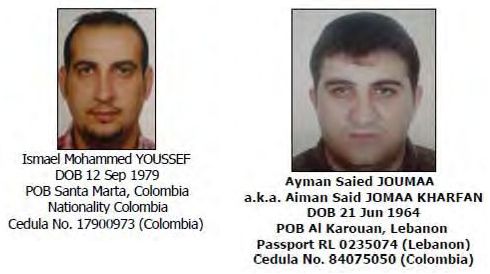
Left: Ismael Mohammed Yousef (apparently a Lebanese national), Ayman Joumaa's Colombian contact (treasury.gov); Right: Ayman Joumaa in a photograph released by the U.S. Department of Treasury. (treasury.gov)
According to the indictment, Ayman Joumaa had close relations with Hezbollah and was a middleman between Hezbollah and various drug cartels. According to American officials, he also transferred funds to Hezbollah through the Lebanese Canadian Bank.[48] In addition, not only did Joumaa transfer funds to Hezbollah through the Lebanese Canadian Bank, he was involved with other financial institutions in Lebanon: Hassan Ayash Exchange, New Line Exchange Trust and Lebanese-based SOLMAR. He apparently used these institutions to launder money and/or transfer funds to Hezbollah (See chart below).[49] It was also reported that according to the findings of the investigation, an Iranian plane made weekly drug runs between Venezuela and Syria[50] (in our assessment it may have been an Iranian-Syrian “service” for Hezbollah’s drug business).
The case of Ayman Joumaa also demonstrated how Hezbollah exploits the Lebanese banking system. The following flowchart outlines the involvement of the Lebanese Canadian Bank in laundering drug money and funneling it to Hezbollah. The chart, based on statements made by American officials, appeared in the New York Times on December 13, 2011:
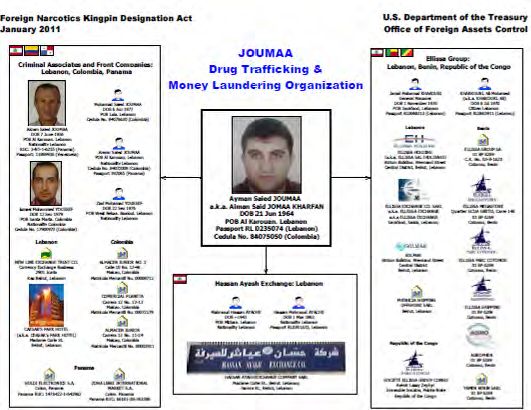
Department of Treasury chart of Ayman Joumaa's criminal associations with institutions, organizations, and individuals. (treasury.gov)
Following are more examples of criminal activities involving Hezbollah operatives exposed in Latin America in recent years:
1) In April 2009 17 people were arrested on the Caribbean island of Curaçao for involvement in a drug trafficking network with connections to Hezbollah. The suspects included four Lebanese nationals. The arrests led to the interception of two cocaine shipments totaling 2,000 kg (4,400 pounds).[51]
2) In February 2010 three Lebanese were arrested in the city of Ciudad del Este in the triple frontier region on charges of aiding and abetting Hezbollah. One of the suspects, an American national of Lebanese origin named Moussa Ali Hamdan, purchased pirated cellular telephones and Sony PlayStation gaming consoles to launder Hezbollah money. The other two, Amer al-Husni and Nimr Ali Zuaitar, were arrested for possession of a large quantity of cocaine destined for the United States.[52]
3) In April 2010 Hezbollah activist Jamal Yousef was arrested in New York for possession of 100 M-16 assault rifles, 100 AR-15 rifles, 2,500 grenades, explosives and ammunition. He claimed that the weapons, which had been stored in Mexico, were stolen in Iraq with the help of his cousin, a Hezbollah activist. Jamal Yousef was an arms dealer and had connections with drug cartels, which he apparently supplied with weapons in exchange for cocaine.[53]
4) In July 2010 Hezbollah operative Jameel Nasr was arrested in Mexico. Nasr, a Mexican citizen, was allegedly tasked with establishing an extensive Hezbollah network in Mexico and throughout South America. According to the Kuwaiti newspaper Al-Siyasa, he frequently traveled to Lebanon to receive instructions for creating a network for Hezbollah and Iran’s Revolutionary Guards.[54]
This section is part of the study dealing with Iranian and Hezbollah activities in Latin America. The other two sections can be found here:
- Section I – Terrorism: Latin America as an arena for Iranian-Hezbollah terrorism.
- Section III – Subversion and exporting the Islamic Revolution: Exporting radical Islam and Shi’a, and fostering hatred for the United States and its allies (including Israel) in Latin America as part of Iran’s global strategy.
![]()
Notes:
[30] thomas.loc.gov.
[31] foreignaffairs.house.gov. Norman Bailey is President of the Institute for Global Economic Growth and a professor at the Institute of World Politics in Washington. He is a former member of the National Security Council and the Office of the Director of National Intelligence (DNI).
[32] Theamericasreport.com, July 12, 2011.
[33] http://www.el-universal.com.mx, July 28, 2008.
[34] See our April 2, 2007 Information Bulletin: “Using the Quds Force of the Revolutionary Guards as the main tool to export the revolution beyond the borders of Iran.”
[35] See Sara A. Carter, “Hezbollah uses Mexican drug routes into U.S.,” The Washington Times, March 27, 2009.
[36] www.aei.org.
[37] See Thomas Donnelly, “Quds and Zetas,” The Weekly Standard, October 12, 2011.
[38] thomas.loc.gov.
[39] See Roger F. Noriega and Jose R. Cardenas, “The mounting Hezbollah threat in Latin America,” AEI, October 2011.
[40] About 8,000 people of Maicao’s total population of 58,000 are Arabs, who dominate the city’s commerce. According to earlier reports, many Arab residents donate some of their income to Hezbollah through banks in Venezuela and Panama (“Hezbollah and Hugo Chavez: Radical Islam’s Western Foothold,” by Samuel Pickell, University of Kansas, 2010).
[41] CRS report.
[42] For the main findings of the RAND report, see ITIC study on Hezbollah’s activities in Latin America (April 2009).
[43] CRS report quoting U.S. Department of State, “Country Reports on Terrorism 2009,” August 2009.
[44] In a DEA operation referred to as “Operation Titan” (foreignaffairs.house.gov).
[45] foreignaffairs.house.gov.
[46] youtube.com.
[47] treasury.gov, youtube.com.
[48] analysisintelligence.com, justice.gov, youtube.com, investigativeproject.org.
[49] www.treasury.gov, youtube.com.
[50] youtube.com.
[51] AP, April 29, 2009; guardian.co.uk.
[52] publicintelligence.info, infosurhoy.com.
[53] publicintelligence.info, www.nytimes.com, terrorismawareness.wordpress.com.
[54] publicintelligence.info.



 RSS
RSS

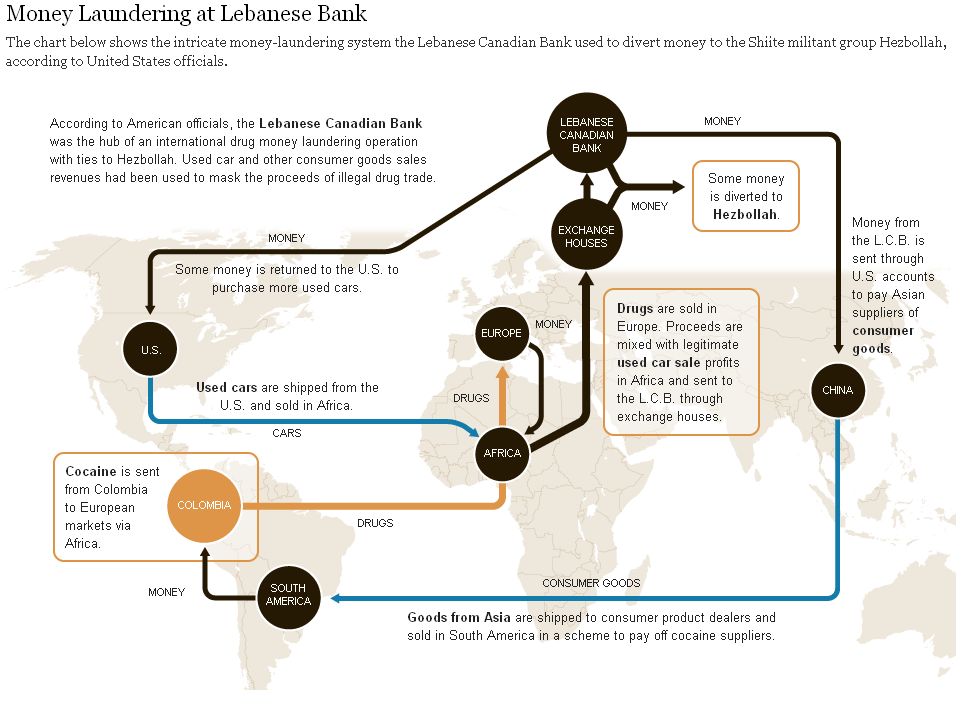

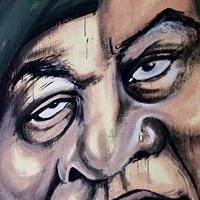
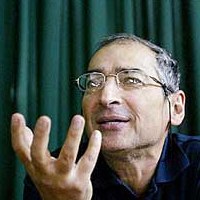
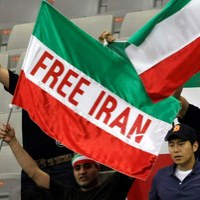





[…] Section II – Criminal activities: Iranian and Hezbollah involvement in criminal activities which serve as a source of revenue and and also serve their subversive and terrorist activities in Latin America. […]